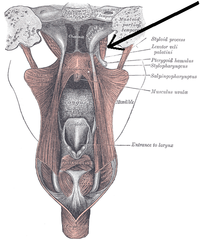Tensor veli palatini muscle
| Tensor veli palatini muscle |
|---|

|
| origin |
| Sphenoid bone ( pterygoid process ), Eustachian tube |
| approach |
| Palatine aponeurosis |
| function |
| Soft palate tensioner |
| Innervation |
| Mandibular nerve |
The tensor veli palatini muscle ( Latin for "soft palate tensioner ") is a strip-shaped skeletal muscle of the head to the side of the levator veli palatini muscle . It arises on the wing extension ( processus pterygoideus ) of the sphenoid bone ( os sphenoidale ) and the side plate of the eustachian tube . Its insertion tendon is deflected by a small hook-shaped bony process ( Hamulus pterygoideus ) of the sphenoid or wing bone . At this point it is underlain by a small bursa . The muscle attaches to the palate aponeurosis ( aponeurosis palatina ). It tightens the soft palate ( velum palatinum , also known as the “soft palate” palatum molle ). The innervation is carried out by a branch ( nervus pterygoideus medialis ) of the nervus mandibularis ( cranial nerve V III ).
Together with the levator veli palatini muscle , the muscle causes the opening of the eustachian tube on the pharynx side and is thus involved in equalizing the pressure between the outside world and the middle ear . In horses , the muscle lies on the airbag valve and regulates its opening.
Individual evidence
- ↑ Federative Committee on Anatomical Terminology (FCAT): Terminologia Anatomica. Thieme, Stuttgart 1998, ISBN 3-13-114361-4 .